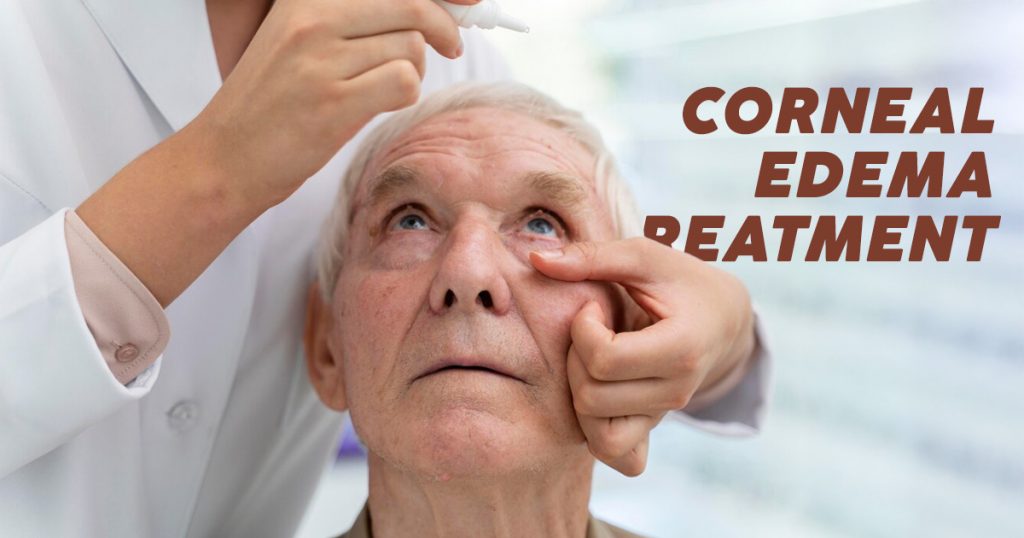Corneal edema, also known as corneal swelling, occurs when fluid builds up in the cornea, causing vision problems and discomfort. The cornea, a clear, dome-shaped shield, plays a crucial role in directing light to the retina. When fluid builds up, vision may blur, light sensitivity can increase, and discomfort might follow. Understanding what causes corneal swelling, the available treatments, and how to manage symptoms can help preserve eye health and prevent complications.
What Causes Corneal Swelling?
The cornea relies on a thin layer of cells called the endothelium to pump out excess fluid. When this layer becomes damaged, fluid collects behind the cornea, leading to swelling. Several conditions and factors can contribute to corneal edema, including:
- Fuchs’ Endothelial Dystrophy – A hereditary disease that gradually destroys endothelial cells, often appearing after age 50.
- Eye Infections and Inflammation – Conditions such as herpes simplex keratitis and iritis can cause corneal swelling.
- Glaucoma – Increased eye pressure can damage the endothelium, leading to corneal edema.
- Eye Surgery Complications – Cataract surgery and other procedures can harm endothelial cells, sometimes resulting in pseudophakic corneal edema.
- Medications and Chemical Exposure – Some eye drops, antiseptics, and anesthetics can contribute to corneal swelling.
- Contact Lens Overuse – Prolonged wear can irritate the cornea and interfere with fluid regulation.
- Eye Trauma – Injuries to the eye can harm the cornea, disrupting its function and causing fluid to accumulate, which may affect vision.
Recognizing Symptoms of Corneal Edema
Corneal swelling may appear suddenly or progress over time, depending on its cause. Symptoms often include:
- Blurred or cloudy vision that may worsen in the morning
- Halos around lights, especially at night
- Eye pain or discomfort
- A scratchy or foreign body sensation
- Light sensitivity
- Tenderness when touching the eye
- Blisters on the cornea in severe cases
When Should You See a Doctor?
Corneal edema can progressively get worse, so early detection is key to protecting vision. Mild cases might not need urgent care, but some symptoms signal the need for a doctor’s evaluation.
Seek Medical Care If You Experience
- Persistent Blurred Vision – Temporary blurriness in the morning may be normal, but if it lasts throughout the day, consult an eye specialist.
- Worsening Eye Pain – Persistent or intensifying eye pain that doesn’t improve with over-the-counter remedies may indicate a more serious problem.
- Severe Light Sensitivity – Difficulty tolerating bright lights or the appearance of halos around lights could indicate significant corneal swelling.
- Persistent Gritty Sensation – A constant feeling of something in the eye may indicate corneal irritation or damage.
- Blisters on the Cornea – Fluid-filled blisters can develop in advanced cases, leading to severe discomfort and vision impairment.
- Sudden Vision Changes – Any rapid loss of vision or noticeable worsening should be addressed immediately to prevent complications.
If symptoms persist despite treatment, an eye doctor can determine whether additional intervention, such as surgery, is necessary. Early diagnosis and proper care can help prevent long-term vision problems.
Corneal Swelling Treatment: Managing Mild to Severe Cases
The approach to treatment varies based on the cause and severity of the swelling. Mild cases may improve with basic remedies, while severe cases might need medical treatment or surgery.
Non-Surgical Treatments
- Corneal Edema Eye Drops and Ointments – Hypertonic saline drops, such as Muro 128, help draw out excess fluid.
- Medications – Antibiotics treat bacterial infections, antiviral drugs address herpes-related edema, and corticosteroids reduce inflammation.
- Bandage Contact Lenses – Special soft lenses provide relief for corneal blisters.
- Blow-Drying Technique – Holding a hairdryer at arm’s length and directing warm air toward open eyes can help evaporate excess moisture.
- Addressing Underlying Conditions – Managing glaucoma, infections, or autoimmune disorders may reduce swelling.
Surgical Treatments
Severe corneal edema that significantly impacts vision may require surgical intervention to restore clarity and eye health.
- Descemet’s Stripping Endothelial Keratoplasty (DSEK) – It replaces the damaged endothelial layer, allowing for quicker healing and improved vision.
Penetrating Keratoplasty (PK) – A full-thickness corneal transplant that replaces the entire cornea, often requiring a longer recovery and vision correction.
Is Corneal Edema Curable?
Corneal edema can be managed effectively, but its durability depends on the cause. Less severe cases can be managed with treatment, but advanced cases might necessitate a corneal transplant for vision restoration. Early diagnosis and proper care improve the chances of maintaining clear vision.
Maintaining Eye Health and Preventing Corneal Edema
Taking steps to protect the eyes can help prevent corneal swelling and reduce the risk of complications.
- Regular Eye Exams – Routine check-ups detect early signs of endothelial damage.
- Proper Contact Lens Care – Following hygiene guidelines prevents irritation and infection.
- Managing Medical Conditions – Keeping glaucoma, diabetes, and autoimmune diseases under control helps preserve corneal health.
- Using Medications Safely – Avoiding prolonged use of eye drops with preservatives minimizes risks.
- Wearing Eye Protection – Safety glasses shield the eyes from injury and exposure to harmful substances.
Seeing Clearly: Managing Corneal Edema for a Healthier Future
Corneal edema can impact vision and quality of life, but effective treatments are available to manage symptoms and improve eye health. Identifying what causes corneal swelling, seeking timely medical care, and following appropriate treatment options can help prevent serious complications. Whether through corneal edema eye drops, medication, or surgery, maintaining clear vision is possible with the right approach.
